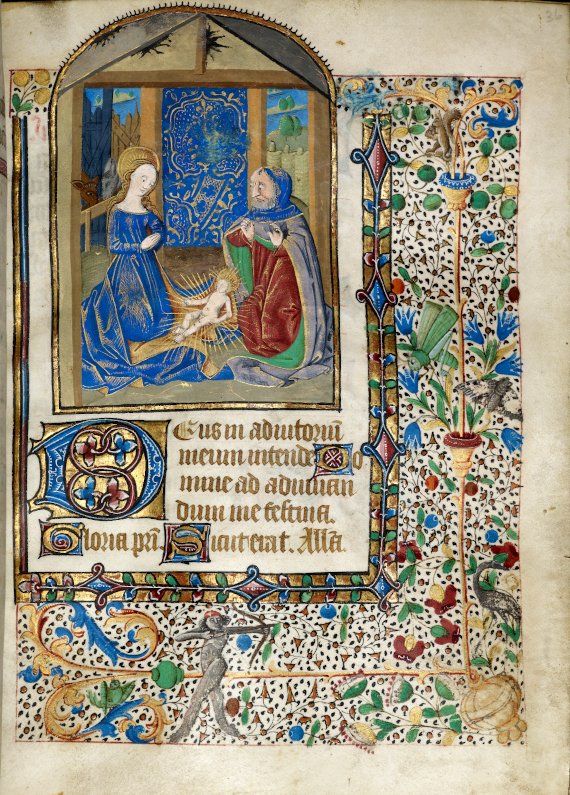- About
- Visiting
- What’s On
- Venue hire
- Catalogues
- Collections
- 101 Treasures of Chetham’s
- Digital Resources
- The Flowers of Histories
- A Book of Hours from France
- The Manchester Scrapbook
- Thomas Barritt of Manchester
- Art Treasures Examiner of 1857
- Manchester Association for Constitutional Order
- The North Western Museum of Science and Industry: Some Reminiscences by Richard Hills
- Criminal Manchester
- The Cup of Destiny
- Athenaeum Souvenir
- Middle English Manuscripts
- Manchester and Liverpool of Today
- Hollingworth’s Mancuniensis
- Memoir of Cecil Wray
- William Seward’s Diary
- The Anti-Monopolist
- Fishwick’s History of Rochdale
- Knyvett’s Defence of this Realm
- Tractatus de Nigromantia
- Axon Ballads
- Printed Books & Ephemera
- Archives & Manuscripts
- Prints and Photographs
- Blog
- Support us
A Book of Hours from France
Lord thou shalt open my lips

This manuscript is a largely complete Book of Hours made for the Use of Coutances (a diocese in Normandy and centre of manuscript production) in the second half of the fifteenth century. To expand on this a little, the name Book of Hours is a term that can be applied to books that present many separate ‘Little Offices’, series of prayers to say through the day with particular devotions in mind.
This particular MS was the gift of the descendants of John Byrom in 1870. We will add more about this manuscript as we pass through the liturgical seasons and feasts in 2021.
The Nativity

Chetham’s Library MS A.3.132 fol. 36r
The Little Office of the Blessed Virgin Mary is the most widely used and the most frequently found of these prayer sequences, and the Nativity scene here is conventionally attached, as here, to the hour of Prime, the first of the shorter daytime hours that follow Matins and Lauds as the first daylight prayer sequence. The invocatory opening prayer is still in use and is familiar to us in English through the Book of Common Prayer:
Deus in adiutorium meum intende; Domine ad adiuvandum me festina. Gloria Patri, et Filio, et Spiritui Sancto; sicut erat in principio et in secula seculorum. Alleluia.
O God, make speed to save us. O Lord, make haste to help us. Glory be to the Father and to the Son and to the Holy Spirit, as it was in the beginning, is now, and ever shall be, world without end.
![]()
The Presentation in the Temple
According to the laws of Moses, the Mosaic Law, every firstborn male was to be considered to belong particularly to God, in thanks for the first passover in Egypt, when the destroying angel spared the Israelites’ sons. It was also the case that a woman who had given birth was to go to the temple for the first time forty days after her delivery and offer sacrifice. Luke’s Gospel (2, xxii-xl) tells the story of the journey of Jesus, Mary and Joseph to Jerusalem to satisfy these provisions, and of the reception of Jesus by the Prophets Simeon and Anna. Simeon’s declaration, as translated in the 1662 Book of Common Prayer is:
Lord, now lettest thou thy servant depart in peace according to thy word.
For mine eyes have seen thy salvation,
Which thou hast prepared before the face of all people;
To be a light to lighten the Gentiles and to be the glory of thy people Israel.
This prophecy, vitally important for Christian theology as it extends Jesus’ status as Saviour to all the peoples of the world, the ‘Gentiles’, has been translated, paraphrased and set to music countless times. It is often known as ‘Nunc Dimittis’ (Now you dismiss) from the first two words of the passage as they appear in the traditional Latin text of the Bible, the Vulgate:
Nunc dimittis servum tuum, Domine, secundum verbum tuum in pace:
Quia viderunt oculi mei salutare tuum
Quod parasti ante faciem omnium populorum:
Lumen ad revelationem gentium, et gloriam plebis tuae Israel.
The tiny image here (much smaller even than the nativity above) is no more than the size of a large postage stamp, but is full of detail and solemnity, though the figure of Simeon, his face appearing between Mary and Joseph, has a beatific smile.
The feast of Candlemas is still celebrated on 2 February by many Christian denominations, and is attested as early as the fourth century AD in Jerusalem. The feast is seen by many as the final day of the Christmas season.



